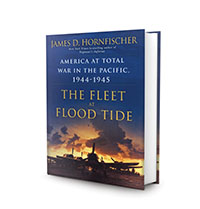
In June 1944, on the eve of the invasion of Saipan, Admiral Chester W. Nimitz, commander of joint forces in the Pacific Ocean Areas, had estimated that the Pacific War had passed through three phases. In the first, Japan expanded while America recovered from Pearl Harbor, secured lines of communication, and stopped the Japanese at Midway. The second phase ended in mid-1943 with the capture of the southern Solomons. As a consequence of the third, the February 1944 conquest of the Marshalls, American forces cracked the outer barrier of Japan’s defenses.
Each phase brought the United States closer to Japan’s home islands. But Operation Forager, the American offensive to neutralize Japanese bases in the Mariana Islands and Palau, heightened the stakes of winning—and the consequences for losing. Japanese warlords considered the perimeter connecting the Marianas, the western Carolines, and western New Guinea as a tripwire to finish the fight in the Pacific. Meanwhile, Americans were intent on leveraging a “powerful triad” of naval power, amphibious assault, and strategic aviation to force unconditional surrender.
In the process, author James D. Hornfischer argues persuasively in The Fleet at Flood Tide that both sides passed a threshold into total war. Yet it was Japanese leaders’ adherence to a policy of “bloody status quo” that dictated the endgame. After Saipan, two truths emerged: “A great victory was in hand…and far worse lay ahead.”
In contrast to his earlier work, The Last Stand of the Tin Can Sailors (2004), Hornfischer’s new book paints a bigger canvas, one exploring the conquests of the Marianas (and to a lesser extent, Leyte, Iwo Jima, and Okinawa), the Great Marianas Turkey Shoot, the B-29 raids on Japan, and the use of atomic bombs.
Throughout, Hornfischer adheres to a narrative he describes as “at the level of How Things Work,” illustrating how the actions of soldiers, sailors, and airmen combined to achieve victory. In doing so, he deploys a fine cast of strategic and tactical characters. Strategically, Fifth Fleet Commander Raymond A. Spruance represents high seas naval might; Amphibious Forces Commander Richmond Kelly Turner, the projection of that might ashore; and U.S. Army Air Forces’ Colonel Paul Tibbets, the advent of a new aerial strategic weapon—the atomic bomb. There is also plenty of battle action involving submariners, B-29 crews, UDT frogmen, Marines and GIs, even Amtrak drivers. With a more panoramic narrative, the drama in The Fleet at Flood Tide is more episodic and less visceral—but by no means less propulsive.
In a very real sense the book is also a Spruance testimonial. He, in Hornfischer’s words, “emerges as the indispensable man.” During the Battle of the Philippine Sea, Spruance hewed to the strategy of capturing Saipan while his aviation admirals agitated to chase after Japanese carriers. In short, “Spruance saw his mission as larger than sinking enemy ships.” Perhaps most significantly, the admiral stood in sharp contrast to the “frenetic desperate death cult that was imperial Japan.”
—New Jersey-based writer David Sears is a historian and frequent contributor to World War II.
This review was originally published in the January/February 2017 issue of World War II magazine. Subscribe here.





